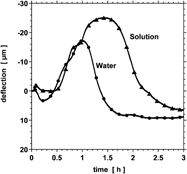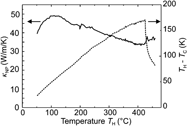Refine search
Actions for selected content:
106100 results in Materials Science
Stick-slip dynamics and recent insights into shear banding in metallic glasses
-
- Journal:
- Journal of Materials Research / Volume 26 / Issue 12 / 28 June 2011
- Published online by Cambridge University Press:
- 27 June 2011, pp. 1453-1463
- Print publication:
- 28 June 2011
-
- Article
- Export citation
Demonstration of Er3+ diffusivity and solubility increases in off-congruent, Li-deficient LiNbO3 crystal
-
- Journal:
- Journal of Materials Research / Volume 26 / Issue 12 / 28 June 2011
- Published online by Cambridge University Press:
- 27 June 2011, pp. 1524-1531
- Print publication:
- 28 June 2011
-
- Article
- Export citation
JMR volume 26 issue 12 Cover and Front matter
-
- Journal:
- Journal of Materials Research / Volume 26 / Issue 12 / 28 June 2011
- Published online by Cambridge University Press:
- 27 June 2011, pp. f1-f4
- Print publication:
- 28 June 2011
-
- Article
-
- You have access
- Export citation
JMR volume 26 issue 12 Cover and Back matter
-
- Journal:
- Journal of Materials Research / Volume 26 / Issue 12 / 28 June 2011
- Published online by Cambridge University Press:
- 27 June 2011, pp. b1-b4
- Print publication:
- 28 June 2011
-
- Article
-
- You have access
- Export citation
The chemomechanics of crystallization during rewetting of limestone impregnated with sodium sulfate
-
- Journal:
- Journal of Materials Research / Volume 26 / Issue 12 / 28 June 2011
- Published online by Cambridge University Press:
- 27 June 2011, pp. 1472-1481
- Print publication:
- 28 June 2011
-
- Article
- Export citation
Phase formation at the Sn/Cu interface during room temperature aging: Microstructural evolution, whiskering, and interface thermodynamics
-
- Journal:
- Journal of Materials Research / Volume 26 / Issue 12 / 28 June 2011
- Published online by Cambridge University Press:
- 27 June 2011, pp. 1482-1493
- Print publication:
- 28 June 2011
-
- Article
- Export citation
Atomistic modeling of the Al–H and Ni–H systems
-
- Journal:
- Journal of Materials Research / Volume 26 / Issue 12 / 28 June 2011
- Published online by Cambridge University Press:
- 27 June 2011, pp. 1552-1560
- Print publication:
- 28 June 2011
-
- Article
- Export citation
Formation of interfacial η′-Cu6Sn5 in Sn–0.7Cu/Cu solder joints during isothermal aging
-
- Journal:
- Journal of Materials Research / Volume 26 / Issue 12 / 28 June 2011
- Published online by Cambridge University Press:
- 27 June 2011, pp. 1468-1471
- Print publication:
- 28 June 2011
-
- Article
- Export citation
Novel growth mode of solid–liquid–solid (SLS) silica nanowires
-
- Journal:
- Journal of Materials Research / Volume 26 / Issue 17 / 14 September 2011
- Published online by Cambridge University Press:
- 23 June 2011, pp. 2232-2239
- Print publication:
- 14 September 2011
-
- Article
- Export citation
Thermal characterization of vertical silicon nanowires
-
- Journal:
- Journal of Materials Research / Volume 26 / Issue 15 / 14 August 2011
- Published online by Cambridge University Press:
- 23 June 2011, pp. 1958-1962
- Print publication:
- 14 August 2011
-
- Article
- Export citation
Low-temperature synthesis and characterization of PVP-capped FeAu nanoparticles
-
- Journal:
- Journal of Materials Research / Volume 26 / Issue 16 / 28 August 2011
- Published online by Cambridge University Press:
- 23 June 2011, pp. 2040-2049
- Print publication:
- 28 August 2011
-
- Article
- Export citation
Electrostatic charging and manipulation of semiconductor nanowires
-
- Journal:
- Journal of Materials Research / Volume 26 / Issue 17 / 14 September 2011
- Published online by Cambridge University Press:
- 23 June 2011, pp. 2305-2310
- Print publication:
- 14 September 2011
-
- Article
- Export citation
Synthesis of water soluble silver-nanoparticle-embedded polymer nanofibers with poly(2-ethyl-2-oxazoline) by a straightforward polyol process
-
- Journal:
- Journal of Materials Research / Volume 26 / Issue 13 / 14 July 2011
- Published online by Cambridge University Press:
- 21 June 2011, pp. 1614-1620
- Print publication:
- 14 July 2011
-
- Article
- Export citation
Low-temperature synthesis of Zn3P2 nanowire
-
- Journal:
- Journal of Materials Research / Volume 26 / Issue 12 / 28 June 2011
- Published online by Cambridge University Press:
- 21 June 2011, pp. 1464-1467
- Print publication:
- 28 June 2011
-
- Article
- Export citation
Low-voltage organic transistor with subfemtoliter inkjet source–drain contacts
-
- Journal:
- MRS Communications / Volume 1 / Issue 1 / November 2011
- Published online by Cambridge University Press:
- 20 June 2011, pp. 3-6
- Print publication:
- November 2011
-
- Article
- Export citation
Molecular dynamics simulations of gold-catalyzed growth of silicon bulk crystals and nanowires
-
- Journal:
- Journal of Materials Research / Volume 26 / Issue 17 / 14 September 2011
- Published online by Cambridge University Press:
- 16 June 2011, pp. 2199-2206
- Print publication:
- 14 September 2011
-
- Article
- Export citation
Photocatalytic activity enhancement of TiO2 porous thin film due to homogeneous surface modification of RuO2
-
- Journal:
- Journal of Materials Research / Volume 26 / Issue 12 / 28 June 2011
- Published online by Cambridge University Press:
- 16 June 2011, pp. 1532-1538
- Print publication:
- 28 June 2011
-
- Article
- Export citation
The influence of ∑3 twin boundaries on the formation of radiation-induced defect clusters in nanotwinned Cu
-
- Journal:
- Journal of Materials Research / Volume 26 / Issue 14 / 28 July 2011
- Published online by Cambridge University Press:
- 16 June 2011, pp. 1666-1675
- Print publication:
- 28 July 2011
-
- Article
- Export citation
JMR volume 26 issue 11 Cover and Front matter
-
- Journal:
- Journal of Materials Research / Volume 26 / Issue 11 / 14 June 2011
- Published online by Cambridge University Press:
- 10 June 2011, pp. f1-f4
- Print publication:
- 14 June 2011
-
- Article
-
- You have access
- Export citation
JMR volume 26 issue 11 Cover and Back matter
-
- Journal:
- Journal of Materials Research / Volume 26 / Issue 11 / 14 June 2011
- Published online by Cambridge University Press:
- 10 June 2011, pp. b1-b4
- Print publication:
- 14 June 2011
-
- Article
-
- You have access
- Export citation
















